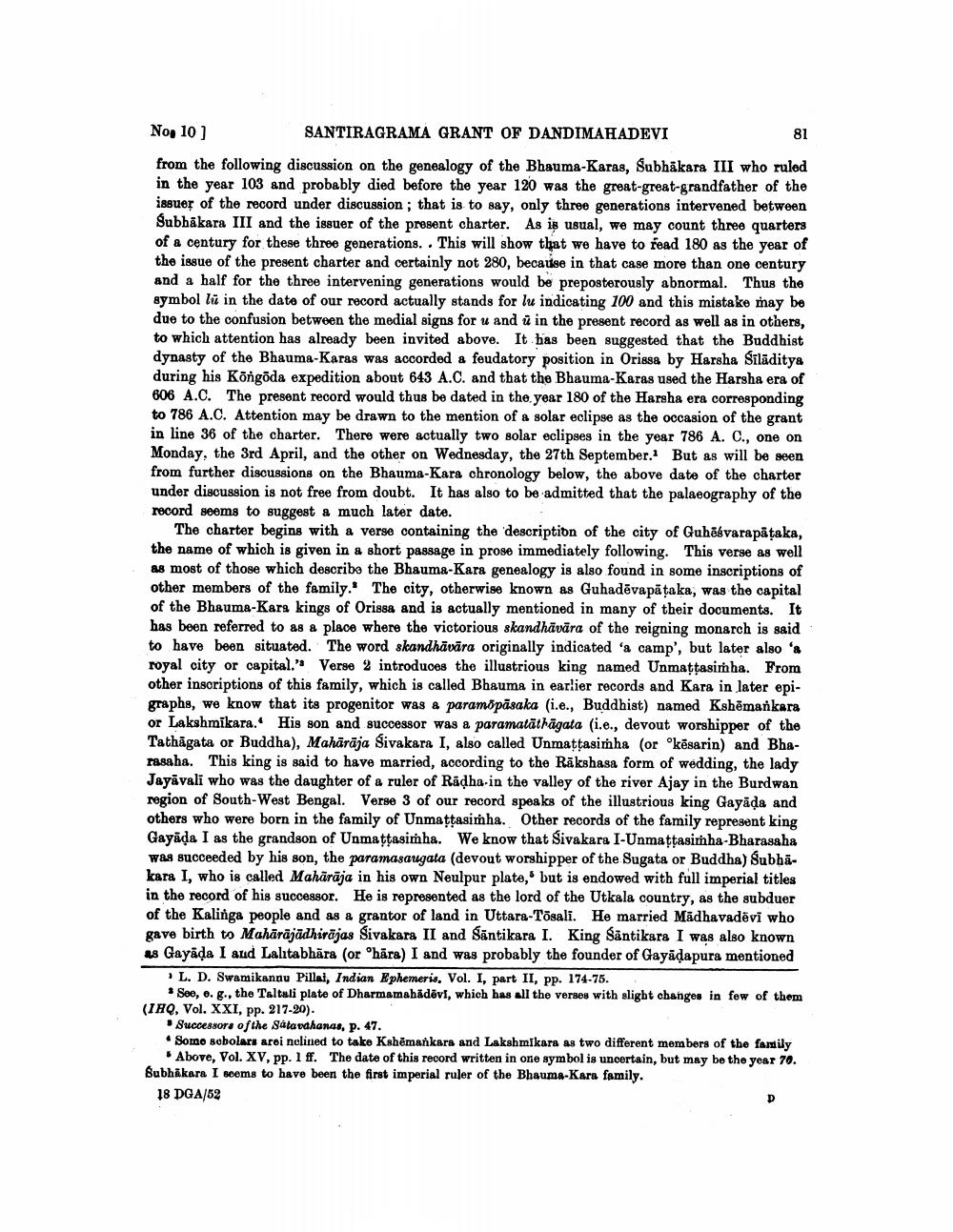________________
No, 10 ] SANTIRAGRAMA GRANT OF DANDIMAHADEVI
81 from the following discussion on the genealogy of the Bhauma-Karas, Subhākara III who ruled in the year 103 and probably died before the year 120 was the great-great-grandfather of the issuer of the record under discussion ; that is to say, only three generations intervened between Subhākara III and the issuer of the present charter. As is usual, we may count three quarters of a century for these three generations. . This will show that we have to read 180 as the year of the issue of the present charter and certainly not 280, because in that case more than one century and a half for the three intervening generations would be preposterously abnormal. Thus the symbol lü in the date of our record actually stands for lu indicating 100 and this mistake may be due to the confusion between the medial signs for u and ů in the present record as well as in others, to which attention has already been invited above. It has been suggested that the Buddhist dynasty of the Bhauma-Karas was accorded a feudatory position in Orissa by Harsha Silāditya during his Köngöda expedition about 643 A.C. and that the Bhauma-Karas used the Harsha era of 606 A.C. The present record would thus be dated in the year 180 of the Harsha era corresponding to 786 A.C. Attention may be drawn to the mention of a solar eclipse as the occasion of the grant in line 36 of the charter. There were actually two solar eclipses in the year 786 A. C., one on Monday, the 3rd April, and the other on Wednesday, the 27th September. But as will be seen from further discussions on the Bhauma-Kara chronology below, the above date of the charter under discussion is not free from doubt. It has also to be admitted that the palaeography of the record seems to suggest a much later date.
The charter begins with a verso containing the description of the city of Guhakvarapätaka, the name of which is given in a short passage in prose immediately following. This verse as well as most of those which describe the Bhauma-Kara genealogy is also found in some inscriptions of other members of the family. The city, otherwise known as Guhadēvapătaka, was the capital of the Bhauma-Karg kings of Orissa and is actually mentioned in many of their documents. It has been referred to as a place where the victorious skandhävāra of the reigning monarch is said to have been situated. The word skandhāvāra originally indicated 'a camp', but later also '& royal city or capital." Verse 2 introduces the illustrious king named Unmattasimha. From other inscriptions of this family, which is called Bhauma in earlier records and Kara in later epigraphs, we know that its progenitor was a paramöpāsaka (i.e., Buddhist) named Kshēmankara or Lakshmikara. His son and successor was a paramatāthāgata (i.e., devout worshipper of the Tathāgata or Buddha), Mahārāja Sivakara I, also called Unmattasimha (or "kēsarin) and Bharasaha. This king is said to have married, according to the Rākshasa form of wedding, the lady Jayāvali who was the daughter of a ruler of Radha in the valley of the river Ajay in the Burdwan region of South-West Bengal. Verse 3 of our record speaks of the illustrious king Gayada and others who were born in the family of Unmattasimha. Other records of the family represent king Gayāda I as the grandson of Unmattasimha. We know that Sivakara I-Unmaţtasimha-Bharasaha was succeeded by his son, the paramasaugata (devout worshipper of the Sugata or Buddha) Subhākara I, who is called Mahārāja in his own Neulpur plate, but is endowed with full imperial titles in the record of his successor. He is represented as the lord of the Utkala country, as the subduer of the Kalinga people and as a grantor of land in Uttara-Tösali. He married Madhavadëvi who gave birth to Mahārājādhirājas Sivakara II and Santikara I. King Säntikara I was also known as Gayāda 1 and Lalitabhāra (or "hāra) I and was probably the founder of Gayādapura mentioned
· L. D. Swamikannu Pillai, Indian Ephemeris, Vol. I, part II, pp. 174-75.
* See, 0. 8., the Taltali plate of Dharmamahadovi, which has all the verses with slight changes in few of them (IHQ, Vol. XXI, pp. 217-20).
• Successors of the Sátardhands, p. 47. • Somno sobolars arei nclined to take Kshēmankara and Lakshmikara as two different members of the family
. Above, Vol. XV, pp. 1 ff. The date of this record written in one symbol is uncertain, but may be the year 70. Subhakara I seems to have been the first imperial ruler of the Bhauma-Kara family.
18 DGA/52




